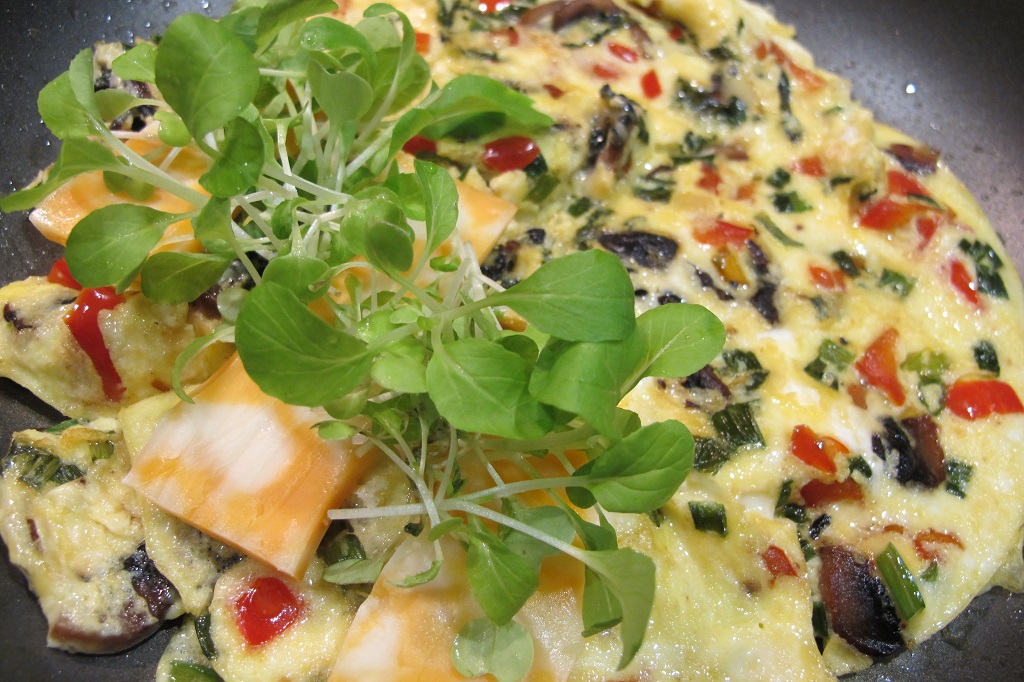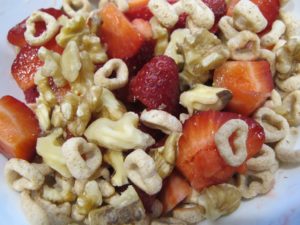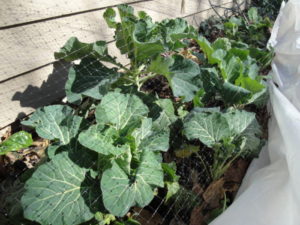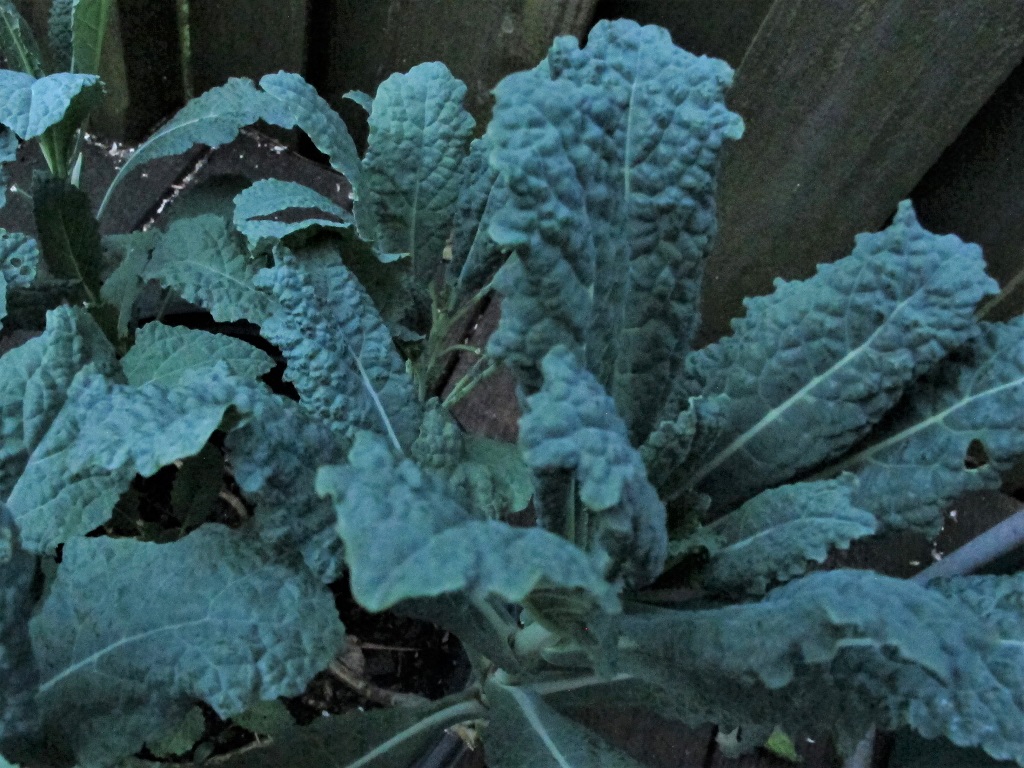Page 2
The Veggie Omelet With Greens

A veggie omelet, with cheese and microgreens in the fold.
Plain eggs? Nah! Any version of a veggie omelet was a Sunday morning tradition for the two of us, and an easy way to get Mother to eat more greens:
- Sauté (low-medium heat) sliced white button mushrooms and part of a chopped ripe bell pepper in extra virgin olive oil and butter until slightly softened.
- Add a chopped green onion, and any combination of chopped greens you prefer (dinosaur or ‘Red Russian’ kale, arugula, a big handful of spinach, mustard greens, etc.). Turn often to soften the greens.
- Crack 2 large eggs into a bowl, and mix with 1 tablespoon of milk, a finely chopped sage leaf (optional), and a bit of black pepper.
- When the veggies have softened, add butter, if needed, then pour in the egg mixture. Low to low-medium heat.
- When the bottom has congealed, turn the egg over. It can overcook (turn brown) quickly, so watch closely. If it breaks apart, just push the pieces back together.
- Add your favorite cheese on half of the omelet while the egg sets. Avocado, fresh tomato, and young microgreens or broccoli sprouts are more options.
- Lower the heat or turn it off once the egg has cooked.
- Fold the plain half over the cheese. It’s ready when the cheese has melted.
- Add a dash of salt to the finished omelet. We can easily detect salt on the surface of food, so it’s not necessary to infuse it throughout. We use less salt this way.
Add sliced strawberries or some cantaloupe on the side. I prefer rye bread for its lower glycemic index, or a slice of good whole wheat, but bread or a bagel is optional. Hard to turn it down, though.
Instead of using only butter in cooking, I substitute olive oil for part of it. Salt, refined carbohydrates, and saturated fats: less is better for most of us.
Juice?
I rarely served orange juice (with pulp) because of the high sugar content in fruit juices. My mother looked forward to an omelet once or twice a week, and my brother and sister-in-law sometimes joined us, bringing the bagels.
This could be a new tradition—Sunday morning with family or friends, and a veggie omelet! An omelet is also a quick fix for dinner.
Or Cereal?

If you like the convenience of cereal for breakfast, include a handful of walnuts or sliced almonds, some strawberries, and half a peach or banana. Protein and fiber stave off hunger for several hours. Look for cereals with fewer grams of carbohydrates. Yes, that means reading the nutrition labels. Some of those healthy looking “natural” grain cereals have the highest levels of carbohydrates.
This might bring shock and horror to some, but most mornings I have plain Cheerios for breakfast. I have 1/2 cup of the cereal, which is only 1/3 of an adult’s serving, adding nuts and fruits, of course. An adult serving has only 1 gram of added sugar. Blueberries (and strawberries, too) lose their antioxidant effect when combined with dairy products, so I’ll eat the more expensive blueberries 2-3 hours after breakfast.
In recent years, a controversy arose over General Mills’ claim that their product is “heart healthy”. The claim has been substantiated with research to the satisfaction of the Food and Drug Administration. In February, in recognition of Heart Health Month, you’ll find little cereal hearts in the box but they’re in there at other times as well. (Why not oatmeal for me, you ask? The texture…)
How It All Began
As local farmers’ markets grew in popularity beginning in the late 1980’s and 1990’s, some of my customers requested particular kinds of plants. The suburbs of Washington, D.C., where I lived, were home to people from all over the world—the Far East, India, Africa, the Middle East, Europe, Central and South America, the Caribbean islands… Apparently, they ate a lot more healthy greens than we did.
In response to their requests, I grew plants that weren’t seen on supermarket shelves at that time. For a few years, two women from Russia asked me to grow lovage and root parsley for them. Others asked for Callaloo, purslane (high in Omega-3’s), miniature broccoli, and wrinkled cress (bright, peppery flavor). The list of varieties grew longer each year.
Names such as ‘Yukina Savoy’, Chinese cabbage, ‘Hon Tsai Tai’, pac choi, tatsoi, Viroflay spinach, mustard spinach, and dinosaur kale made the seed order forms. And winter leeks, mesclun mixes, ‘Nabechan’ bunching onions, arugula ‘Astro’, miniature broccoli ‘Happy Rich’, and red-leaved heirloom French lettuces. These healthy selections were in addition to all the other herb, vegetable, and flowering transplants I raised and sold. This was too much fun!
In order to retain some credibility with other customers who wanted to try them, I had to come up with ways to prepare this produce. So that meant eating more of it ourselves. And I passed along growing recommendations that yielded the biggest, most beautiful plants, so my customers would enjoy equal success.
Close To Home
Around the same time, both parents were diagnosed with cardiovascular disease and my mother with type 2 diabetes.
In the U.S. each year, 895,000 people have heart attacks and 795,000 have strokes. Over 37 million have diabetes (90-95% with type 2 diabetes), and 96 million more are estimated by the Centers for Disease Control to have pre-diabetes (perhaps 80% are unaware they have it). Ask your doctor for a simple blood test to confirm or to rule it out. Those numbers are growing each year.
With two little children, back in the ’80’s and ’90’s, I needed to know where we stood. Imagine my surprise when the doctor said I was pre-diabetic. And I thought we were eating well, making “healthy” whole wheat bread and brown rice! Growing lots of vegetables! Plenty of physical exercise! We never drank soda, and I hadn’t eaten red meat since I was a teenager, except for bacon now and then. Some homemade almond crescents, chocolate, or pumpkin pie? Yes, on occasion.
The doctor advised getting more exercise and eating less fat. Still, the A1C test results didn’t budge. The A1C test measures the amount of sugar coating the red blood cells. It indicates how well your body has utilized insulin and maintained blood glucose levels over 2 or 3 months. Okay…what else can I do?
The Food Pyramid
Carbohydrates were recognized as a significant inflammatory agent. And yet, at that point, grains (carbohydrates) occupied the largest tier of the U.S. Department of Agriculture’s food pyramid. I was hearing more about inflammation as a significant factor in heart disease, although cholesterol is still seen by many as the primary culprit.
It wasn’t until we cut our consumption of carbohydrates—both simple and complex—and consumed more greens that my A1C finally came down to a healthy range. Bagels, cookies, crackers, pasta, rice, fruit juice, and potatoes made rare appearances. What did take center stage were the leafy greens (brassicas every day), primarily, and colorful vegetables. We also ate more blueberries and strawberries from the markets, fresh salmon from Cameron’s Seafood once a week, and nuts every day.
The newest iteration of the FDA’s dietary recommendations is the MyPlate program. It shows 5 divisions: 2 of them—half the plate—contain fruits and vegetables; grains and proteins make up the other half. A glass on the side represents dairy products. That’s it! But this is way too simple and doesn’t offer much value.
But How Safe Are the Complex Carbs?
Whole wheat pasta and bread are still high in carbohydrates. But eating fiber and protein along with carbs helps slow down the absorption of sugars, moderating insulin spikes. I usually skip the 2 slices of bread and eat what’s between them—a spoonful of peanut butter and half a banana, or chicken salad on mixed greens. Where possible, I cut the carbs, regardless of the source.
Also, on those rare occasions when I make mashed potatoes, I don’t peel the potatoes before simmering them. The cooked pieces go through the ricer, but the skins aren’t tossed out. Instead, they’re processed with milk, and then added back to the bowl, increasing the amount of fiber and nutrients.
Shrimp scampi with linguine is healthier when using less pasta and more greens and vegetables. I also use pasta with extra fiber, Omega-3 fatty acids, and protein. In all the dishes with pasta or brown rice (carbs) as a base, I decrease the carbs and increase the vegetables, especially the greens.
A serving size as listed on a package of spaghetti is surprisingly small (only 2 ounces), so long gone are the heaping mounds of cooked pasta.
The Insulin Response
The beta cells of the pancreas produce a hormone called insulin. As insulin courses through our bloodstream, it enables cells to take in and metabolize sugars, giving our muscles and other tissues the energy needed to function normally. The pancreas regulates blood sugar levels by pumping out insulin as the need arises.
Some people don’t make any insulin. Type 1 diabetes is treated with injections, diet, and daily monitoring. Before insulin was discovered in 1921, diabetes was managed with what is known today as the ketogenic diet. That involves eating very low amounts of carbohydrates, but I don’t know how successful it was.
In this country, millions of us have type 2 diabetes, formerly called “adult-onset diabetes”. But because increasing numbers of children have been diagnosed with it, this condition has been renamed “type 2 diabetes”. People with this condition fail to make enough insulin or resist the effects and can’t maintain healthy blood glucose levels. That’s insulin resistance.
Our lifestyle choices contribute to type 2 diabetes—obesity, lack of physical activity, and poor diet. But family genotype and ethnicity also play a part. My mother no longer needed most of her prescriptions for type 2 diabetes after improving her diet (eating what I’d prepared), and she lost 40 pounds.
Too Many Carbs
A diet composed of too many carbohydrates, especially refined carbs (fruit juice and sugary drinks, candy, cookies, white bread, white rice, processed foods), overloads the body with high blood sugar levels. Those beta cells in the pancreas work overtime to supply insulin to rid the blood of all that sugar.
Adopting better eating habits helps control the condition, but many patients require medication. Eventually, those pancreas cells can become impaired and degrade, unable to manufacture insulin at all.
Uncontrolled type 2 diabetes leads to greater risk of heart disease, kidney disease, vision impairment, neuropathy, and amputation.
In Conclusion
If I’ve encouraged some of you to commit to making a few changes, then I’m thrilled. The first step is the hardest one to take, and it’s the most important one.
With healthy greens in the garden or a few pots on the balcony, you can pick “Just One Leaf” when it’s needed. Chop it up and add it when reheating pizza or use it fresh in a salad. Go one step further and add more leaves to the sauce, the stir-fry, or even a store-bought can of soup. Just one or two leaves of kale or collards contain most of the RDV’s (recommended daily value) for several vitamins and minerals, and extremely beneficial antioxidants, as well.
For the brassicas (arugula, broccoli, Brussels sprouts, cabbage, cauliflower, collards, gai lan, kale, mustard greens, pac choi, tatsoi, turnip greens) you’ll benefit from the antioxidant group, called the sulforaphanes, if you eat them raw or chop them and let them sit on the counter for 40+ minutes. An enzyme in brassicas—myrosinase—works on damaged plant tissues and transforms sulforaphane precursors into the sulforaphanes themselves. The enzyme, though, is destroyed by heat. So, if you cook the brassicas right away, you won’t get any of those sulforaphanes. No other plant families have these beneficial antioxidants—just the brassicas!
If you can’t wait that long to cook the brassicas, eat a few raw pieces. This introduces myrosinase to your system, which will work on the rest of the cooked greens you’ll be eating.
Broccoli is surprisingly high in protein, and its leaves are edible, too! One medium-large ripe lunchbox pepper has 100% of the RDV of Vitamin C. The next time you’re at the grocery store or the farmers’ market, add a bunch of fresh arugula, gai lan, spinach, or a bag of those colorful lunchbox peppers to your purchase.
For me, a series of factors came together at roughly the same time:
- the rise of the farmers’ markets and customers’ requests for specific crops
- our family’s medical history
- nutritional research and access to the information
- and the determination to eat wisely in order to prevent or at least to delay the onset of chronic illness.
So, all the facts were there; it just required action on my part.
Here’s to a long, healthy future—yours and mine!
Links:
Seedlings For Your Garden: 12 Tips
Herb Gardens: How To Grow Herbs In Pots
10 Tips for Protecting Cool Season Vegetables
Grow A Potted Tomato: A Step-By-Step Guide
Starting Seeds for Cool Season Greens
Grow Microgreens Indoors: Healthy and So Simple
Collards Soup: Comfort Food for Winter
Easy Broccoli One and Easy Broccoli Two: Recipes
Time To Think About Fall Greens and Vegetables
Vegetables In Containers: How To Grow Them
Soil Prep 101 for Your Vegetable Garden
Headings
Page 1: Tomato-Basil Salad, But First, A Tribute To My Mother (Stress, Nevertheless, Takotsubo Two!), Add Just a Little More Green (Greens In Small Steps, Just One Leaf, But I Miss My…), Eat Your Colors, and Add these to your salad…
Page 2: The Veggie Omelet (Juice?, Or Cereal?), How It All Began (Close To Home, The Food Pyramid), But How Safe Are the Complex Carbs? (The Insulin Response, Too Many Carbs), In Conclusion, and Links

